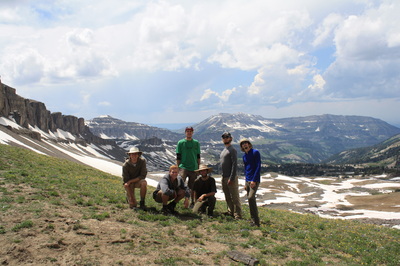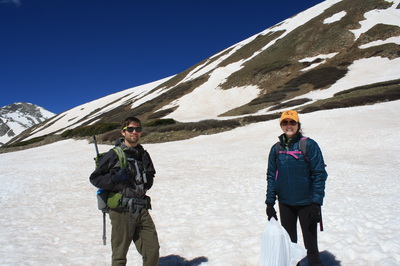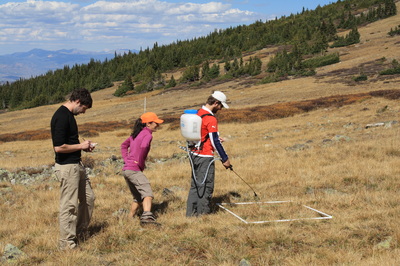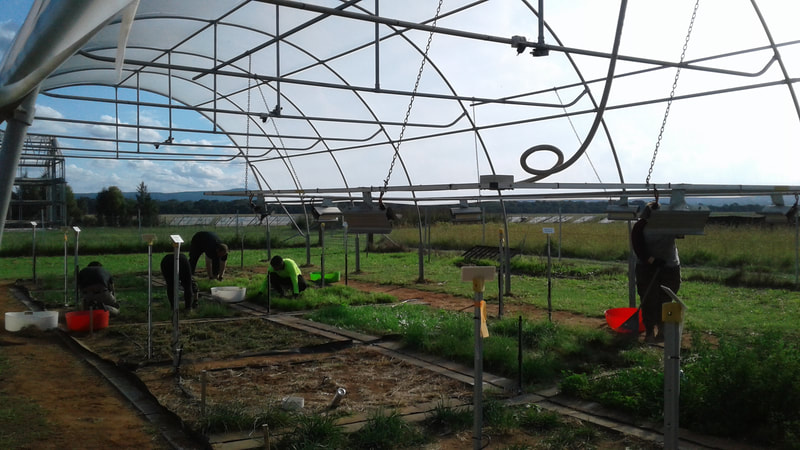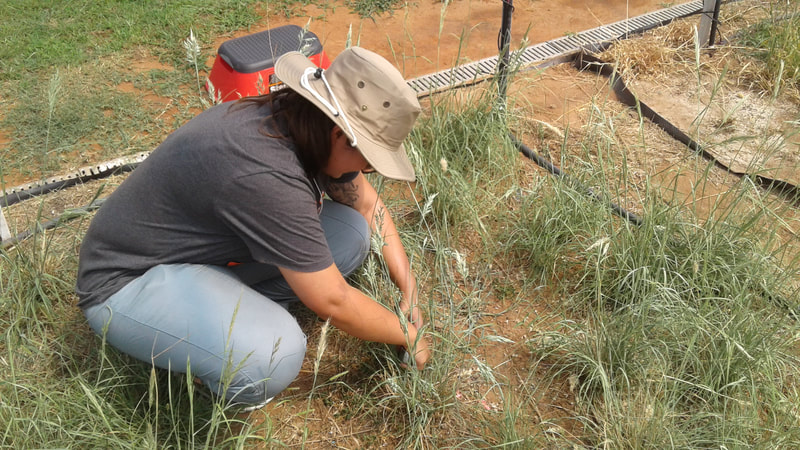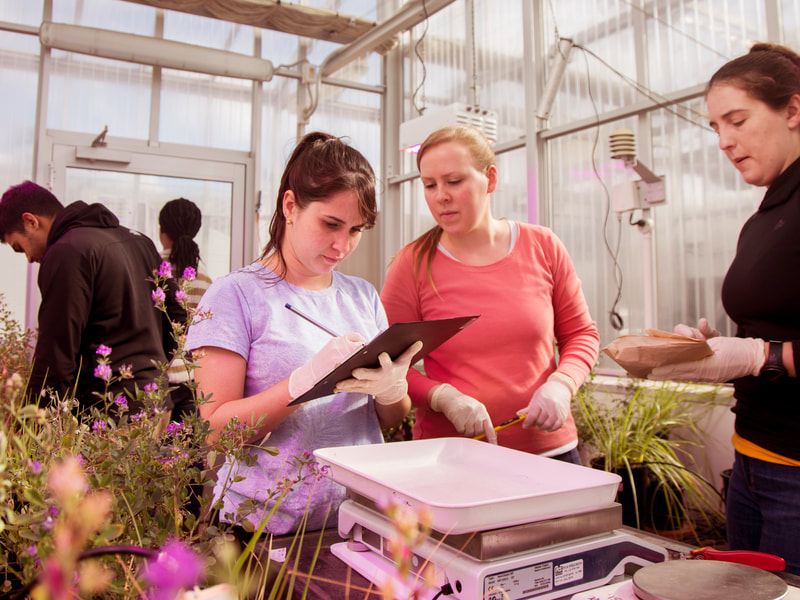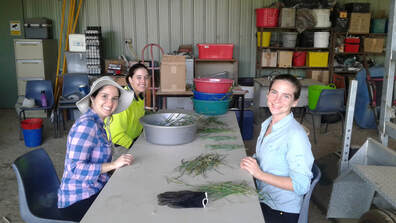
One of my favorite parts of being a scientist is having the opportunity to train mentees. During my PhD I took a peer-led seminar focused on learning about explicit styles and techniques associated with good mentoring and we published original research highlighting a need for training in mentoring for early career scientists. This training provided me with specific tools for best practices and improved my mentoring in several concrete ways, including that I am mindful of being flexible in accommodating my mentees diverse needs and previous experiences to develop projects that are suited toward their goals.
Graduate (HDR) Advising at the Hawkesbury Institute for the Environment
As one of the core Post-docs on the Pastures and Climate Extremes Experiment, my role interfaced directly with our graduate students on their projects. Check out some of our collaborative projects that have been published here and here- with many more to come!
Undergraduate Advising
My philosophy on being a scientist includes substantial emphasis on mentoring undergraduate students in plant ecology, and guiding them to explore science in general and research in particular as a career option. My research has always involved undergraduate students while offering them a chance to develop their own research questions and learning goals, and I describe some of those projects below. As a Post-doc at UMN I am keenly interested in supporting students conducting field work in ecology, and I mentored students at Cedar Creek during the summers of 2021 and 2022 through the Cedar Creek Intern Program, as well as through the College of Biological Science Undergraduate Intern program during the academic year. Please feel free to contact me with any questions or to plan for a project!
As a Postdoctoral Fellow at UMN based at Cedar Creek, I worked with many students on independent research projects through the Cedar Creek Intern Program including:
Simulating Wholescale Ecological Drought in a Grassland Community: Student- Stephanie Varghese (California State LA) with Dr. Forest Isbell and Dr. Sasha Wright
Impact of drought on floral abundance along an old-field chronosequence: Student- Annika Fagerstrom (Friends University)
Predicting old-field responses to drought using dominant grass seed and leaf traits: Student- Anna Manson (UMN) with Amy Waananen
Soil organic matter and abiotic soil properties in the old fields: Students- Hannah Vanderscheuren (University of Wisconsin) & Mackenzie Groth (UMN) with Hanan Farah
Bison Grazing and Burning Frequency Effects on Insect Herbivory: Students- Liz Muschler (Carlton College) & Eleanor Muzzy (UMN) with Dr. Neha Mohan Babu
Effect of drought on forage quality in oak savanna: Student- Adam Weber (Michigan Tech Uni)
Effects of drought and secondary succession on tiller density: Student- Genevieve Tosevin (Boston Uni)
Leaf area index responses to drought in fields with and without former agricultural use: Student- Gillian Meyers (Georgetown Uni)
The effects of drought on floral diversity and abundance over time at Cedar Creek: Student- Madeline Miller (UMN), with Maggie Anderson
The effects of global change treatments on floral diversity over time at Cedar Creek: Student- Grace Doyle (Macalester College), with Maggie Anderson
Influences of drought and increased temperature on pollinator visitation rates: Student- Madison Dunlap (Gustavus Adolphus College), with Maggie Anderson
Linking grass/forb proportional abundance under future warming and drought to pollinator focused conservation: Student- Stephanie Varghese (California State Uni LA)
The relationship of AMF, C, and water stable aggregates along an old-field chronosequence: Student- Adrian Ruybe (Uni Texas El Paso), with Hanan Farah
Consequences of manipulating relative humidity in early successional old-fields under drought: Student- Brooke Bernhardt (Gustavus Adolphus College), with Hanan Farah and Maria Parks
As a Research Fellow at WSU I worked with a number of students on funded research experiences through the WSU Summer Scholars Program including:
Effects of drought on plants and pollinators
Student: Gina Herrmann, with Dr. Amy-Marie Gilpin and Dr. Jinyan Yang (Summer 2020-2021)
This project focused on grassland floral resources and how these may be impacted under altered precipitation patterns under future climate conditions as part of the Community Interactions subgroup of the DRI-Grass facility, a long-term grassland drought manipulation experiment at Hawkesbury Campus. Floral resources are assess remotely using field mounted cameras to track flowering activity among the species growing in this community.
What is the future cooking up for hungry cattle? Pasture nutrition under climate extremes
Student: Minh Doan, with Dr. Ben Moore and Karen Catunda (Summer 2019-2020)
This project focused on the shifts in plant elemental composition (using X-ray fluorescence) among pasture species in response to drought and warming.
Understanding the PACE of Climate Change
Students: Alexandra Boyd, Samantha Weller, and Shania Therese Didier Serre, with Dr. Sally Power and Dr. Elise Pendall (Summer 2018-2019)
This project included an introduction to a variety of different methods for our students, and each worked with a unique subset of field or glasshouse data to learn data analysis and graphing skills.
As a PhD student the University of Colorado Boulder I worked with UROP students, BURST students and undergraduate student volunteers, in addition to securing funding for periodic full-time summer positions in association with grants. Some of the research projects are described below:
Summer 2016
Tyler Justice (EBIO, University of Colorado Boulder) and I are worked together on a project designed to address a key research gap linking landscape-scale heterogeneity with controls on the ecosystem process of nitrogen cycling in alpine environments, especially for areas receiving elevated levels of ambient nitrogen deposition.
Summer 2015
Ben Crawford (EBIO, University of Colorado Boulder) and I developed a project titled "Threats to the alpine: potential losses of plant diversity in response to changes in nitrogen deposition" to highlight changes in the plant composition of three alpine plant communities responding to a multi-year manipulation increasing nitrogen deposition.
Summer 2013
George Libby (EBIO, University of Colorado Boulder) and I developed a project titled " Differences in herbivore presence between alpine meadow communities in the CO Rocky Mountains."
Colin Luben (EBIO, University of Colorado Boulder) and I developed a project titled "The effect of nitrogen deposition on krummholz recruitment and establishment at alpine treeline".
Drew Meyers (EBIO, University of Colorado Boulder) completed a BURST project titled: "Alpine moist meadow response to gradients of nitrogen deposition in the Rocky Mountains"
Summer 2012
Matthew Ribarich (EBIO/ENVS, University of Colorado Boulder) completed a BURST project titled: "Plant community effects on alpine ecosystem response to nitrogen deposition" during the summer field season.
While a MS student at UAF I also mentored student projects as part of the Alaskan Peatland Experiment
Summer 2011
Beth Brown (REU student, University of Chicago) completed a project titled: "Ecological consequences of drainage in Alaskan peatlands: a look at carbon cycling and moss productivity"
Chris Dorich (REU student, University of New Hampshire) completed the second year of data collection for a project titled "Light response curves of Alaskan peatland vegetation"
Graduate (HDR) Advising at the Hawkesbury Institute for the Environment
As one of the core Post-docs on the Pastures and Climate Extremes Experiment, my role interfaced directly with our graduate students on their projects. Check out some of our collaborative projects that have been published here and here- with many more to come!
Undergraduate Advising
My philosophy on being a scientist includes substantial emphasis on mentoring undergraduate students in plant ecology, and guiding them to explore science in general and research in particular as a career option. My research has always involved undergraduate students while offering them a chance to develop their own research questions and learning goals, and I describe some of those projects below. As a Post-doc at UMN I am keenly interested in supporting students conducting field work in ecology, and I mentored students at Cedar Creek during the summers of 2021 and 2022 through the Cedar Creek Intern Program, as well as through the College of Biological Science Undergraduate Intern program during the academic year. Please feel free to contact me with any questions or to plan for a project!
As a Postdoctoral Fellow at UMN based at Cedar Creek, I worked with many students on independent research projects through the Cedar Creek Intern Program including:
Simulating Wholescale Ecological Drought in a Grassland Community: Student- Stephanie Varghese (California State LA) with Dr. Forest Isbell and Dr. Sasha Wright
Impact of drought on floral abundance along an old-field chronosequence: Student- Annika Fagerstrom (Friends University)
Predicting old-field responses to drought using dominant grass seed and leaf traits: Student- Anna Manson (UMN) with Amy Waananen
Soil organic matter and abiotic soil properties in the old fields: Students- Hannah Vanderscheuren (University of Wisconsin) & Mackenzie Groth (UMN) with Hanan Farah
Bison Grazing and Burning Frequency Effects on Insect Herbivory: Students- Liz Muschler (Carlton College) & Eleanor Muzzy (UMN) with Dr. Neha Mohan Babu
Effect of drought on forage quality in oak savanna: Student- Adam Weber (Michigan Tech Uni)
Effects of drought and secondary succession on tiller density: Student- Genevieve Tosevin (Boston Uni)
Leaf area index responses to drought in fields with and without former agricultural use: Student- Gillian Meyers (Georgetown Uni)
The effects of drought on floral diversity and abundance over time at Cedar Creek: Student- Madeline Miller (UMN), with Maggie Anderson
The effects of global change treatments on floral diversity over time at Cedar Creek: Student- Grace Doyle (Macalester College), with Maggie Anderson
Influences of drought and increased temperature on pollinator visitation rates: Student- Madison Dunlap (Gustavus Adolphus College), with Maggie Anderson
Linking grass/forb proportional abundance under future warming and drought to pollinator focused conservation: Student- Stephanie Varghese (California State Uni LA)
The relationship of AMF, C, and water stable aggregates along an old-field chronosequence: Student- Adrian Ruybe (Uni Texas El Paso), with Hanan Farah
Consequences of manipulating relative humidity in early successional old-fields under drought: Student- Brooke Bernhardt (Gustavus Adolphus College), with Hanan Farah and Maria Parks
As a Research Fellow at WSU I worked with a number of students on funded research experiences through the WSU Summer Scholars Program including:
Effects of drought on plants and pollinators
Student: Gina Herrmann, with Dr. Amy-Marie Gilpin and Dr. Jinyan Yang (Summer 2020-2021)
This project focused on grassland floral resources and how these may be impacted under altered precipitation patterns under future climate conditions as part of the Community Interactions subgroup of the DRI-Grass facility, a long-term grassland drought manipulation experiment at Hawkesbury Campus. Floral resources are assess remotely using field mounted cameras to track flowering activity among the species growing in this community.
What is the future cooking up for hungry cattle? Pasture nutrition under climate extremes
Student: Minh Doan, with Dr. Ben Moore and Karen Catunda (Summer 2019-2020)
This project focused on the shifts in plant elemental composition (using X-ray fluorescence) among pasture species in response to drought and warming.
Understanding the PACE of Climate Change
Students: Alexandra Boyd, Samantha Weller, and Shania Therese Didier Serre, with Dr. Sally Power and Dr. Elise Pendall (Summer 2018-2019)
This project included an introduction to a variety of different methods for our students, and each worked with a unique subset of field or glasshouse data to learn data analysis and graphing skills.
As a PhD student the University of Colorado Boulder I worked with UROP students, BURST students and undergraduate student volunteers, in addition to securing funding for periodic full-time summer positions in association with grants. Some of the research projects are described below:
Summer 2016
Tyler Justice (EBIO, University of Colorado Boulder) and I are worked together on a project designed to address a key research gap linking landscape-scale heterogeneity with controls on the ecosystem process of nitrogen cycling in alpine environments, especially for areas receiving elevated levels of ambient nitrogen deposition.
Summer 2015
Ben Crawford (EBIO, University of Colorado Boulder) and I developed a project titled "Threats to the alpine: potential losses of plant diversity in response to changes in nitrogen deposition" to highlight changes in the plant composition of three alpine plant communities responding to a multi-year manipulation increasing nitrogen deposition.
Summer 2013
George Libby (EBIO, University of Colorado Boulder) and I developed a project titled " Differences in herbivore presence between alpine meadow communities in the CO Rocky Mountains."
Colin Luben (EBIO, University of Colorado Boulder) and I developed a project titled "The effect of nitrogen deposition on krummholz recruitment and establishment at alpine treeline".
Drew Meyers (EBIO, University of Colorado Boulder) completed a BURST project titled: "Alpine moist meadow response to gradients of nitrogen deposition in the Rocky Mountains"
Summer 2012
Matthew Ribarich (EBIO/ENVS, University of Colorado Boulder) completed a BURST project titled: "Plant community effects on alpine ecosystem response to nitrogen deposition" during the summer field season.
While a MS student at UAF I also mentored student projects as part of the Alaskan Peatland Experiment
Summer 2011
Beth Brown (REU student, University of Chicago) completed a project titled: "Ecological consequences of drainage in Alaskan peatlands: a look at carbon cycling and moss productivity"
Chris Dorich (REU student, University of New Hampshire) completed the second year of data collection for a project titled "Light response curves of Alaskan peatland vegetation"
